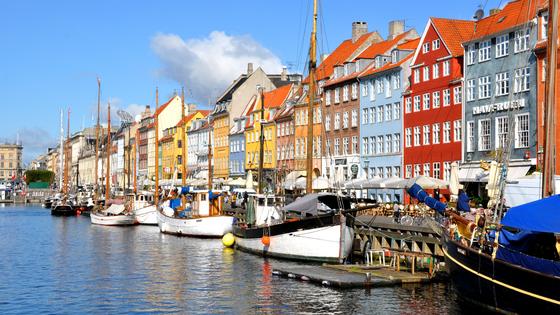Rick Steves’ Europe: Embrace Hygge and Save Cash in Copenhagen
Copenhagen is known for happy people and hygge (pronounced HEW-geh), which means enjoying the cozy simplicity of everyday life, like walking along the beach, or sharing a picnic of smørrebrød (open-faced sandwiches) with a friend. Where else would Hans Christian Andersen, a mermaid statue, and lovingly decorated open-face sandwiches be the icons of a major capital?
For the tourist, Copenhagen is compact. After a busy day cruising the canals, touring its palace, and strolling a shop-lined pedestrian boulevard called the Strøget, you'll feel right at home.
Start your city visit at Rådhuspladsen (City Hall Square), the bustling heart of Copenhagen. This used to be the fortified west end of town. The king cleverly quelled a French revolutionary-type thirst for democracy by giving his people Europe's first great public amusement park, Tivoli, in 1843 – just beyond the city walls. When the train lines came, the station was built next door to Tivoli – for the best possible access to all the fun.
Today the walls and moats of Copenhagen are long gone. They’re replaced by a ring of lush parks and tranquil lakes – so appreciated by the nearly naked sunbathers who savor the short Danish summer – oblivious to all the history that surrounds them.
The train station, Tivoli, and City Hall huddle together. From there, the Strøget pedestrian street stretches through the heart of the old køben (merchant's) havn (harbor) to the old sailor’s quarter, a 15-minute walk away – but don't rush it.
Nyhavn, formerly a sleazy sailors' quarter, lounges comfortably around its canal. A few lonely tattoo parlors and smoky taverns stubbornly defend their salty turf against a rising tide of trendy, expensive cafés. Glamorous sailboats fill the canal. Any historic sloop is welcome to moor here, temporarily joining the fleet that makes up Copenhagen's ever-changing boat museum, a scene of modern-day Vikings gone soft.
While tattoos were once the mark of crusty old sailors, today they are Viking chic. Young Danish bodybuilders showing off muscles, tans, and tattoos, clog the harborside promenade working their way through cases of local beer. The scene is off-putting to many tourists who don’t realize that, in a land with astronomical taxes on serving alcohol in bars, this is just the only affordable way for the normal working-class gang to “go out” for a few beers. I consider the outdoor beer consumption in Denmark no different than the consumption in an English pub…just on the curb rather than at the bar.
The city's most famous (and photographed) citizen, the Little Mermaid, sits demurely a few blocks away, posing patiently for all the tour groups and wondering when a prankster will steal her head again. (The poor mermaid has been victim to decapitation and other acts of vandalism over the past century.)
If your rambles whet your appetite for history, the excellent and curiously enjoyable National Museum traces the Danish civilization from its ancient beginnings. English explanations make the prehistoric passage graves, mummified Viking bodies with armor and weapons, the rustic yet mysteriously exquisite 2,000-year-old Gundestrup Cauldron, ancient lur horns that still can be played, and mead drinking horns particularly interesting.
Copenhagen is one of Europe’s most expensive cities, but smart travelers can keep expenses down without going to extremes. A Copenhagen Card sightseeing pass covers entry to many city sights (including pricey ones, like Tivoli) and local transportation. (It can save money if you plan to visit a lot of attractions, especially the ones with steep entry fees, but do the math to see if it adds up for you.)
Do as the Scandinavians do and stay in budget hotels with shared bathrooms or in hostels (most have private rooms and great breakfasts). Both are respectable options in clean and wholesome Scandinavia. Breakfasts offered at lodgings are all-you-can-eat and so hearty that you’ll need only a light lunch.
Budget travelers eat well with a few tips. Viktualiehandler (small delis) and bagerier (bakeries), found on nearly every corner, sell tasty pastries such as wienerbrød. (These are what the we in the States call a "Danish"). Try the drinkable yogurt, caviar paste in a squeeze tube, creamy Havarti, and dense rugbrød (rye bread). Treats like these make picnics as memorable as they are inexpensive.
Denmark's famous open-face sandwiches cost a fortune in restaurants, but many street corner smorrebrød shops sell them for more reasonable prices. Drop into one of these often no-name, family-run alternatives to Yankee fast food, and get several elegant sandwiches to go. There's no more Danish way to picnic. The tradition calls for three sandwich courses: herring first, then meat, then cheese, washed down with a local beer. "Skål!"
========
(Rick Steves (www.ricksteves.com) writes European guidebooks, hosts travel shows on public TV and radio, and organizes European tours. This column revisits some of Rick's favorite places over the past two decades. You can email Rick at rick@ricksteves.com and follow his blog on Facebook.)
©2024 Rick Steves. Distributed by Tribune Content Agency, LLC.
(c)2024 RICK STEVES DISTRIBUTED BY TRIBUNE MEDIA SERVICES, INC.










